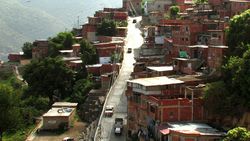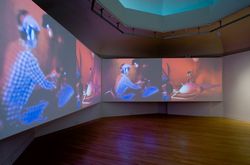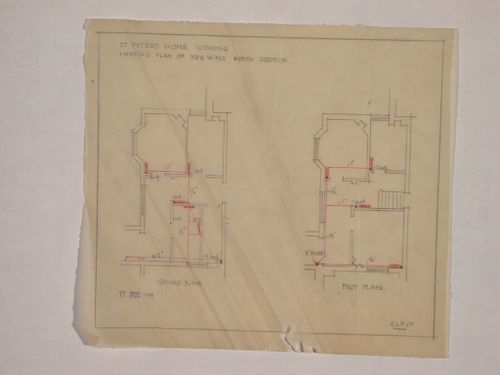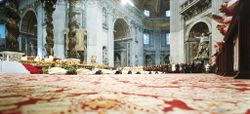Sous-série
AP058.S1.SS1
Description:
This subseries documents Blanche Lemco van Ginkel’s involvement in the Association of Collegiate Schools of Architecture Board (ACSA). During that period of activity with the ACSA, where Mrs. van Ginkel was a member and has occupied the positions of vice-president and president, she was involved in annual and board meetings, the Award Selection Committee, the Strategic Planning Committee, the Jubilee Committee for the “Journal of architectural education”, the conferences for the East Central, Northeast, West, and West Central regions, on task forces on the ACSA mission and on architectural education and practice, etc. Also documented is her attendance in several other meetings and conferences, among them the Five Presidents Meeting, the Administrators Conference, the Wingspread Presidents Meeting, the San Francisco Forum, the Chicago Forum, and the Fifth Technology Conference. The subseries documents as well correspondence between Mrs. van Ginkel, as president, and other institutions or associations, like the National Council of Architectural Registration Boards, the Royal Architecture Institute of Canada, and the Canadian Housing Design Council. The subseries contains correspondence, programmes and scheduled activities, brochures, information packages, notes, reports, minutes, budgets, lists of members, memorandum, posters, and a few ACSA publications, dating from 1977 to 1992.
1977-1992
Association of Collegiate Schools of Architecture Board
Actions:
AP058.S1.SS1
Description:
This subseries documents Blanche Lemco van Ginkel’s involvement in the Association of Collegiate Schools of Architecture Board (ACSA). During that period of activity with the ACSA, where Mrs. van Ginkel was a member and has occupied the positions of vice-president and president, she was involved in annual and board meetings, the Award Selection Committee, the Strategic Planning Committee, the Jubilee Committee for the “Journal of architectural education”, the conferences for the East Central, Northeast, West, and West Central regions, on task forces on the ACSA mission and on architectural education and practice, etc. Also documented is her attendance in several other meetings and conferences, among them the Five Presidents Meeting, the Administrators Conference, the Wingspread Presidents Meeting, the San Francisco Forum, the Chicago Forum, and the Fifth Technology Conference. The subseries documents as well correspondence between Mrs. van Ginkel, as president, and other institutions or associations, like the National Council of Architectural Registration Boards, the Royal Architecture Institute of Canada, and the Canadian Housing Design Council. The subseries contains correspondence, programmes and scheduled activities, brochures, information packages, notes, reports, minutes, budgets, lists of members, memorandum, posters, and a few ACSA publications, dating from 1977 to 1992.
Subseries
1977-1992
L'enseignement de... Caracas
Au Venezuela, la législation autorise la création de consejos communales (conseils communaux), un organe qui permet aux citoyens de se réunir en conseils de quartier formés de membres élus afin de lancer des projets de développement local. Les premières images du film Comuna under construction (2010), de Dario Azzellini et Olivier Ressler, retracent l’histoire d’une(...)
Théâtre Paul-Desmarais
8 mai 2014 , 18h
L'enseignement de... Caracas
Actions:
Description:
Au Venezuela, la législation autorise la création de consejos communales (conseils communaux), un organe qui permet aux citoyens de se réunir en conseils de quartier formés de membres élus afin de lancer des projets de développement local. Les premières images du film Comuna under construction (2010), de Dario Azzellini et Olivier Ressler, retracent l’histoire d’une(...)
Théâtre Paul-Desmarais
Projet
Un dictionnaire
AP041.S1.1970.D2
Description:
UN DICTIONNAIRE consists of black and white photographs of wire-service newspaper articles selected by Charney for their depiction of “people and buildings caught in upheavals”. Charney described these images as “monuments which are created by events outside the confines of architectural institutions”, meaning that buildings and locations assume a “monumental connotation” when they become associated with a significant event. UN DICTIONNAIRE consists of 300 plates, each plate a photograph that “traces the contours of relations which affect our grasp of the significance of buildings”. UN DICTIONNAIRE was presented as an installation at Galerie Catherine & Stéphane de Beyrie in Paris in 1994 and at the Canadian Pavilion of the 7th International Architectural Exhibition in Venice in 2000 as well as at Musée d'art contemporain de Montréal in 2001-2002. The publication “Tracking images : Melvin Charney, un dictionnaire...” related to this project was also realized in collaboration the Canadian Centre for Architecture in 2000. This project series contains correspondence, notes, photographs, installations plans and exhibition space plans related for the aforementioned exhibitions in Paris, at the Venice Biennale and in Montréal. It also contains reprints of panels shown outside the Canadian Pavilion at the Venice Biennale. Source: Montréal : Musée d’art contemporain. (1979) Melvin Charney: Oeuvres 1970-1979. (p. 21-28)
1970-2001
Un dictionnaire
Actions:
AP041.S1.1970.D2
Description:
UN DICTIONNAIRE consists of black and white photographs of wire-service newspaper articles selected by Charney for their depiction of “people and buildings caught in upheavals”. Charney described these images as “monuments which are created by events outside the confines of architectural institutions”, meaning that buildings and locations assume a “monumental connotation” when they become associated with a significant event. UN DICTIONNAIRE consists of 300 plates, each plate a photograph that “traces the contours of relations which affect our grasp of the significance of buildings”. UN DICTIONNAIRE was presented as an installation at Galerie Catherine & Stéphane de Beyrie in Paris in 1994 and at the Canadian Pavilion of the 7th International Architectural Exhibition in Venice in 2000 as well as at Musée d'art contemporain de Montréal in 2001-2002. The publication “Tracking images : Melvin Charney, un dictionnaire...” related to this project was also realized in collaboration the Canadian Centre for Architecture in 2000. This project series contains correspondence, notes, photographs, installations plans and exhibition space plans related for the aforementioned exhibitions in Paris, at the Venice Biennale and in Montréal. It also contains reprints of panels shown outside the Canadian Pavilion at the Venice Biennale. Source: Montréal : Musée d’art contemporain. (1979) Melvin Charney: Oeuvres 1970-1979. (p. 21-28)
Project
1970-2001
« Aujourd’hui, tout est environnement » déclare, au début des années 1970, un journal montréalais. Au cours de la dernière décennie, le terme « environnement » a dominé le discours et la pratique des artistes, architectes, intellectuels et activistes intervenant dans le domaine social. Les visiteurs de l’Expo 67, cet événement qui a attiré l’attention du monde entier sur(...)
Salle octogonale
19 mars 2009 au 23 août 2009
Environnement total : Montréal, 1965-1975
Actions:
Description:
« Aujourd’hui, tout est environnement » déclare, au début des années 1970, un journal montréalais. Au cours de la dernière décennie, le terme « environnement » a dominé le discours et la pratique des artistes, architectes, intellectuels et activistes intervenant dans le domaine social. Les visiteurs de l’Expo 67, cet événement qui a attiré l’attention du monde entier sur(...)
Salle octogonale
archives
Niveau de description archivistique:
Fonds
AP190
Résumé:
The Preston Scott Cohen Eyebeam project records, 2001-2016, consist of 281 digital files that document the architect’s competition entry for the Eyebeam Atelier Museum in New York City, developed in 2001. The archive includes 154 digital models in Rhinoceros, 30 digital models in STL, approximately 90 digital images, one video, and a number of Illustrator, Photoshop, PDF, and Microsoft Word files.
2001-2016
Documents d’archives de Preston Scott Cohen pour le projet Eyebeam
Actions:
AP190
Résumé:
The Preston Scott Cohen Eyebeam project records, 2001-2016, consist of 281 digital files that document the architect’s competition entry for the Eyebeam Atelier Museum in New York City, developed in 2001. The archive includes 154 digital models in Rhinoceros, 30 digital models in STL, approximately 90 digital images, one video, and a number of Illustrator, Photoshop, PDF, and Microsoft Word files.
archives
Niveau de description archivistique:
Fonds
2001-2016
DR1989:0015:042
Description:
- This drawing shows a ground plan and first floor plan in graphite, with pipes and radiators indicated in red pencil. - This work is part of a group of drawings and reprographic prints of drawings for St. Peter's Home, Woking, and St. Peter's Convent, Woking, from the offices of John Loughborough Pearson and Frank Loughborough Pearson (DR1989:0015:011 - DR1989:0015:085 R/V). Composed of contract and working drawings including plans, site plans, sections, and elevations dated between 1881 and 1936, these drawings were sold at auction by the convent along with those for the older institution of St. Peter's Home, Kilburn (DR1989:0015:001 - DR1989:0015:010). Both St. Peter's Home, Kilburn, and St. Peter's Home, Woking were commissioned from John Loughborough Pearson by Benjamin Lancaster. The alterations to the Home at Kilburn were commissioned on behalf of Lancaster's wife, who founded the home and a lay nursing order which ran it. The institution at Woking was founded by Lancaster as a home for incurables in 1882 and dedicated to the memory of his deceased wife (Quiney 67-68, 254-255, and 284). It was probably first known as St. Peter's Home, Woking, not becoming a convent until ca. 1934.
architecture
1926
St. Peter's Home, Woking: Heating plan for the north portion of the new wing
Actions:
DR1989:0015:042
Description:
- This drawing shows a ground plan and first floor plan in graphite, with pipes and radiators indicated in red pencil. - This work is part of a group of drawings and reprographic prints of drawings for St. Peter's Home, Woking, and St. Peter's Convent, Woking, from the offices of John Loughborough Pearson and Frank Loughborough Pearson (DR1989:0015:011 - DR1989:0015:085 R/V). Composed of contract and working drawings including plans, site plans, sections, and elevations dated between 1881 and 1936, these drawings were sold at auction by the convent along with those for the older institution of St. Peter's Home, Kilburn (DR1989:0015:001 - DR1989:0015:010). Both St. Peter's Home, Kilburn, and St. Peter's Home, Woking were commissioned from John Loughborough Pearson by Benjamin Lancaster. The alterations to the Home at Kilburn were commissioned on behalf of Lancaster's wife, who founded the home and a lay nursing order which ran it. The institution at Woking was founded by Lancaster as a home for incurables in 1882 and dedicated to the memory of his deceased wife (Quiney 67-68, 254-255, and 284). It was probably first known as St. Peter's Home, Woking, not becoming a convent until ca. 1934.
architecture
L’enseignement de… Rome
Le cinéaste et photographe Armin Linke fait le point sur les changements sociétaux, la complexité culturelle et la beauté de la Rome contemporaine à travers deux courts métrages et des photographies d’architecture tirées de ses propres archives. Le premier film capture l’envol de 100 000 étourneaux qui se révèle une véritable chorégraphie avec Rome en toile de fond. Linke(...)
Théâtre Paul-Desmarais
5 mars 2009
L’enseignement de… Rome
Actions:
Description:
Le cinéaste et photographe Armin Linke fait le point sur les changements sociétaux, la complexité culturelle et la beauté de la Rome contemporaine à travers deux courts métrages et des photographies d’architecture tirées de ses propres archives. Le premier film capture l’envol de 100 000 étourneaux qui se révèle une véritable chorégraphie avec Rome en toile de fond. Linke(...)
Théâtre Paul-Desmarais
Projet
AP149.S1.2004.PR01
Description:
The project series documents Minimum Cost Housing Group's project of research, design and construction to demonstrate the benefits of urban agriculture as a permanent feature in housing design and urban planning. A first phase of the project, from 2004 to 2007, the study project took place in developping countries in three diffrent sites: Colombo, Sri Lanka; Rosario, Argentina; and Kampala, Uganda. The project was funded by the International Development Research Centre (IDRC) and supported by the ETC-Urban Agriculture Unit in the Netherlands and the Resource centres on Urban Agriculture and Food Security (RUAF). In 2007, a second phase of the project had for objective to implement an urban agriculture production in Montréal. The Minimum Cost Housing Group team created, on McGill Campus, a vegetable garden on the terrace of a parking garage. The project is now known as "Making Edible Campus" and is still on-going. The material in this project series was produced between 2003 and 2010. The project series contains a large collection of working documents and reports submitted to funding institutions, correspondence with collaborators on the three sites, and also photographss of the project in Colombo, Kampala, Rosario sites. Also included are various artefacts related to the sites in the three developping countries and a board game "Gardenpoly" created by the Urban Agriculture seminar students on urban agriculture in Montréal. Promotional panels for the Making Edible Campus are also included.
2003-2010
Urban agriculture demonstration
Actions:
AP149.S1.2004.PR01
Description:
The project series documents Minimum Cost Housing Group's project of research, design and construction to demonstrate the benefits of urban agriculture as a permanent feature in housing design and urban planning. A first phase of the project, from 2004 to 2007, the study project took place in developping countries in three diffrent sites: Colombo, Sri Lanka; Rosario, Argentina; and Kampala, Uganda. The project was funded by the International Development Research Centre (IDRC) and supported by the ETC-Urban Agriculture Unit in the Netherlands and the Resource centres on Urban Agriculture and Food Security (RUAF). In 2007, a second phase of the project had for objective to implement an urban agriculture production in Montréal. The Minimum Cost Housing Group team created, on McGill Campus, a vegetable garden on the terrace of a parking garage. The project is now known as "Making Edible Campus" and is still on-going. The material in this project series was produced between 2003 and 2010. The project series contains a large collection of working documents and reports submitted to funding institutions, correspondence with collaborators on the three sites, and also photographss of the project in Colombo, Kampala, Rosario sites. Also included are various artefacts related to the sites in the three developping countries and a board game "Gardenpoly" created by the Urban Agriculture seminar students on urban agriculture in Montréal. Promotional panels for the Making Edible Campus are also included.
Project
2003-2010
dessins
DR1989:0015:068
Description:
- This work is part of a group of drawings and reprographic prints of drawings for St. Peter's Home, Woking, and St. Peter's Convent, Woking, from the offices of John Loughborough Pearson and Frank Loughborough Pearson (DR1989:0015:011 - DR1989:0015:085 R/V). Composed of contract and working drawings including plans, site plans, sections, and elevations dated between 1881 and 1936, these drawings were sold at auction by the convent along with those for the older institution of St. Peter's Home, Kilburn (DR1989:0015:001 - DR1989:0015:010). Both St. Peter's Home, Kilburn, and St. Peter's Home, Woking were commissioned from John Loughborough Pearson by Benjamin Lancaster. The alterations to the Home at Kilburn were commissioned on behalf of Lancaster's wife, who founded the home and a lay nursing order which ran it. The institution at Woking was founded by Lancaster as a home for incurables in 1882 and dedicated to the memory of his deceased wife (Quiney 67-68, 254-255, and 284). It was probably first known as St. Peter's Home, Woking, not becoming a convent until ca. 1934. - Although the inscription refers to the "cloister", it is the dormitory which is shown in this drawing, according to the current use of the terms (Fleming 1991).
architecture
December 1934
St. Peter's Convent, Woking: Plans for ground floor of the lay Sisters' dormitory and the upper floor of the Sisters' dormitory
Actions:
DR1989:0015:068
Description:
- This work is part of a group of drawings and reprographic prints of drawings for St. Peter's Home, Woking, and St. Peter's Convent, Woking, from the offices of John Loughborough Pearson and Frank Loughborough Pearson (DR1989:0015:011 - DR1989:0015:085 R/V). Composed of contract and working drawings including plans, site plans, sections, and elevations dated between 1881 and 1936, these drawings were sold at auction by the convent along with those for the older institution of St. Peter's Home, Kilburn (DR1989:0015:001 - DR1989:0015:010). Both St. Peter's Home, Kilburn, and St. Peter's Home, Woking were commissioned from John Loughborough Pearson by Benjamin Lancaster. The alterations to the Home at Kilburn were commissioned on behalf of Lancaster's wife, who founded the home and a lay nursing order which ran it. The institution at Woking was founded by Lancaster as a home for incurables in 1882 and dedicated to the memory of his deceased wife (Quiney 67-68, 254-255, and 284). It was probably first known as St. Peter's Home, Woking, not becoming a convent until ca. 1934. - Although the inscription refers to the "cloister", it is the dormitory which is shown in this drawing, according to the current use of the terms (Fleming 1991).
dessins
December 1934
architecture
dessins
DR1989:0015:069
Description:
- This work is part of a group of drawings and reprographic prints of drawings for St. Peter's Home, Woking, and St. Peter's Convent, Woking, from the offices of John Loughborough Pearson and Frank Loughborough Pearson (DR1989:0015:011 - DR1989:0015:085 R/V). Composed of contract and working drawings including plans, site plans, sections, and elevations dated between 1881 and 1936, these drawings were sold at auction by the convent along with those for the older institution of St. Peter's Home, Kilburn (DR1989:0015:001 - DR1989:0015:010). Both St. Peter's Home, Kilburn, and St. Peter's Home, Woking were commissioned from John Loughborough Pearson by Benjamin Lancaster. The alterations to the Home at Kilburn were commissioned on behalf of Lancaster's wife, who founded the home and a lay nursing order which ran it. The institution at Woking was founded by Lancaster as a home for incurables in 1882 and dedicated to the memory of his deceased wife (Quiney 67-68, 254-255, and 284). It was probably first known as St. Peter's Home, Woking, not becoming a convent until ca. 1934. - Although the inscription refers to the "cloister", it is the dormitory which is shown in this drawing, according to the current use of the terms (Fleming 1991).
architecture
1935
St. Peter's Convent, Woking: Plans for the ground floor, including a site plan
Actions:
DR1989:0015:069
Description:
- This work is part of a group of drawings and reprographic prints of drawings for St. Peter's Home, Woking, and St. Peter's Convent, Woking, from the offices of John Loughborough Pearson and Frank Loughborough Pearson (DR1989:0015:011 - DR1989:0015:085 R/V). Composed of contract and working drawings including plans, site plans, sections, and elevations dated between 1881 and 1936, these drawings were sold at auction by the convent along with those for the older institution of St. Peter's Home, Kilburn (DR1989:0015:001 - DR1989:0015:010). Both St. Peter's Home, Kilburn, and St. Peter's Home, Woking were commissioned from John Loughborough Pearson by Benjamin Lancaster. The alterations to the Home at Kilburn were commissioned on behalf of Lancaster's wife, who founded the home and a lay nursing order which ran it. The institution at Woking was founded by Lancaster as a home for incurables in 1882 and dedicated to the memory of his deceased wife (Quiney 67-68, 254-255, and 284). It was probably first known as St. Peter's Home, Woking, not becoming a convent until ca. 1934. - Although the inscription refers to the "cloister", it is the dormitory which is shown in this drawing, according to the current use of the terms (Fleming 1991).
dessins
1935
architecture



